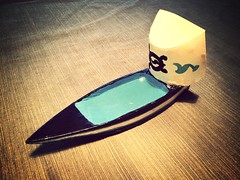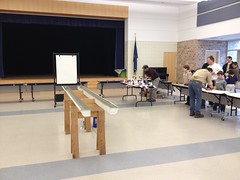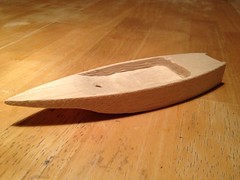 On Saturday, Riley participated in the culminating event of our last week of creative effort, the Raingutter Regatta. The Regatta is an event for cub scouts that involves using a boat-shaped block of balsa wood, a dowel mast, a plastic sheet for a sail, and a few extra plastic and metal pieces to build a breath-powered boat that can be propelled down the length of a rain gutter filled with water.
On Saturday, Riley participated in the culminating event of our last week of creative effort, the Raingutter Regatta. The Regatta is an event for cub scouts that involves using a boat-shaped block of balsa wood, a dowel mast, a plastic sheet for a sail, and a few extra plastic and metal pieces to build a breath-powered boat that can be propelled down the length of a rain gutter filled with water.
The race itself consists of two gutters placed side-by-side, filled half-way with water. Two competitors' boats are placed at one end of the raceway. When the signal is given, each competitor blows on his boat's sail in an attempt to push it toward the finish line. Each scout must use only his breath to push the boat, unless the boat is capsized or stuck, in which case the scout may right or unstick the boat without moving it down the track with his hands. The first boat to arrive at the end of the track wins the heat.
 Our pack's races consisted of a best three out of five heats per race, giving each participant adequate opportunity to account for track disparities (each heat alternates the boats between racing gutters). The races are single-elimination in a 32-slot bracket. There weren't enough boats this year to fill the full 32 slots, so byes were given to some of the younger tiger cub participants to allow them to compete in later brackets.
Our pack's races consisted of a best three out of five heats per race, giving each participant adequate opportunity to account for track disparities (each heat alternates the boats between racing gutters). The races are single-elimination in a 32-slot bracket. There weren't enough boats this year to fill the full 32 slots, so byes were given to some of the younger tiger cub participants to allow them to compete in later brackets.
Our adventure begins back at the pack's Christmas meeting when we received the kit for the boat. The boat materials come in a box that contains everything you need to build the boat except tools, glue, and paint. Apart from those materials, you are not permitted to use anything from outside the box to produce the resultant boat.
We waited quite a long time to decide on a boat design and begin work. In fact, we started constructing the boat only six days before registration. This led to perhaps a hastier construction that we would have liked.
We did some research on the internet for a good boat design. The Caswell District of Eastern North Carolina provided a very informative PDF on the construction of boats. The two fastest designs included in the PDF are the catamaran and the hydroplane. For lack of a good tool for cutting the boat block cleanly in half, we selected the hydroplane design.
The essence of this design is to reduce drag friction between the water and the boat to as little as possible. Typical raingutter regatta boat designs (if you look at the shape of the provided boat block) are very wedge-like. For the boat to move through the water, it must push the water in front of it out its way to the left and right. This creates a significant amount of drag.
 The hydroplane design features a significantly tapered slope of the hull, such that when the boat moves forward, rather than moving the water out of the way, the boat itself moves up over the water. This significantly reduces the friction between the water and boat for a number of reasons, including that there is much less contact surface between the boat and the water than even in some catamaran designs.
The hydroplane design features a significantly tapered slope of the hull, such that when the boat moves forward, rather than moving the water out of the way, the boat itself moves up over the water. This significantly reduces the friction between the water and boat for a number of reasons, including that there is much less contact surface between the boat and the water than even in some catamaran designs.
The usual advantage of a catamaran design is that the weight is distributed over a virtually wide hull. This provides a significant amount of stability in what is typically a light and top-heavy boat (with a high sail). The hull of the catamaran design, if implemented well, also provides the boat with rail-like directional guidance as it moves forward, reducing the need for a rudder.
A disadvantage of the hydroplane is that it purposefully lacks a rudder. This point was not understood by the pack leader when he observed the design. The advantage of the hydroplane boat is its reduced friction between the boat and water - one of the only things that matters in the construction of raingutter regatta boats. By adding a rudder, you significantly increase the friction between the boat and water by dragging the rudder through the water. Instead, an alternate solution is required for properly steering the boat straight or away from the gutter edges, which are the death-knell of speed.
To better enable the hydroplane boat to control its directon, we produced a hyperbolic sail. This sail was unique to our boat design at the race, and was the only sail I saw capable of doing what our sail did. By carefully aiming air at the sail, the direction of the whole boat can be controlled. You can, in fact, steer the boat with this hyperbolic sail. This is impossible on any loose mast design (of which there were many at the race), and not as easily accomplished even with the fixed sail designs of many of the catamarans, due to both the non-parabolic shape of the sail, and the increased yaw resistance provided by the catamaran hulls (a catamaran tends to move directly forward, no matter how you blow on the sail, which causes many hand-corrections when waves or hull anomalies cause the boat to turn into the gutter walls).
In addition to its steering properties, the fixed parabolic sail better catches and focuses the air blown at it, resulting in more efficient application of power. The sail, properly bellowed, can also force the forward hydroplane surface of the boat off the water, thus reducing exposed water surface friction even more. Assuming that you aim the air at the sail properly, these properties can produce extremely fast boat speeds. Of course, the challenge is that the direction of the boat is entirely controlled by the boat operator, and not at all managed by rudders or separated catamaran hulls.
We used a pocket knife and a small Dremel-like sanding tool to shape the bottom of the boat and hollow out the inside. The PDF suggests that extra weight in the boat can lower the boat significantly into the water, which will increase drag. I hollowed out as much as I safely could. Riley helped sand the boat to a smooth finish, and we filled the pre-drilled hole for the unused mast with wood putty.
Riley, Berta, and Abby all painted parts of the boat. Riley helped with the base colors, while Berta painted the racing stripes. Abby painted the Hawaiian turtle design on the sail.
After the decorative painting was complete, I attached the sail to the hull with a hot glue gun and applied a thick layer of polyurethane to waterproof the boat. The hot glue made for an unsightly finish that I regretted immediately, and seemed not to hold as well as it could have. The thick polyurethane layer was suitable, but due to the shape of the boat and the haste with which the construction took place (we applied this layer of paint mere hours before registration), the coating puddled in places, leaving an unsightly yellow haze and even some drips. This did not affect the boat's speed, however.
When tested by me in a Tupperware pool in the kitchen, the boat was insanely fast. In retrospect, we should have had Riley practice using the boat a bit more, since his unfamiliarity with the control aspects of the parabolic sail would be his undoing.
The first race was a close one, as Riley became familiar with the control aspects of his boat. He had to run all 5 heats, as his competitor was able to outpace him due to having better control in the gutter, and not getting stuck as much. When Riley was able to control the boat moving forward without hitting the walls, the boat was rocket-like in speed - without a doubt in my mind, the fastest boat in the pack. In one of the heats, Riley was able to unstick his boat and come from behind a full 2/3rds of a gutter length, but was only barely beaten in that heat due to a final gust from his opponent. In the end, Riley took the race, 3 to 2.
In Riley's second race, I think there were many psychological issues. The surprise of winning one race, the expectation that winning one would result in many wins, competing against the den leader's kid (who wins practically everything, and earned 2nd place only because the boy that beat him was older and had better blowing technique), his parents all giving him advice (some appropriate, some not)... All of these combined to a net loss in merely three heats. Riley was very disappointed. I was disappointed, but not in Riley's performance.
I said at the race that I would not want to do it again. It's a lot of effort to put into something with very little beneficial return. It would be better to build for the joy of building than to be under pressure to build for a race, one whose winning is mostly bound to practice that you can't easily achieve. But as I told Berta, it's like pregnancy: You forget the pain/inconvenience long enough to be convinced having another kid is a good idea. So maybe this time next year we'll want to do it, and possibly produce a better design.
If we were to build a new boat next year, I think I would stick with the parabolic sail, but apply it to a two-hulled hydroplane catamaran, to get the best of all worlds. We'd also see about getting Riley some practice runs in a real gutter before the actual race, so that he can work out how to get the boat to go straight and true and fast.